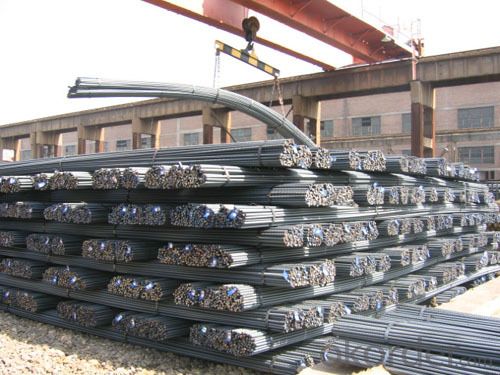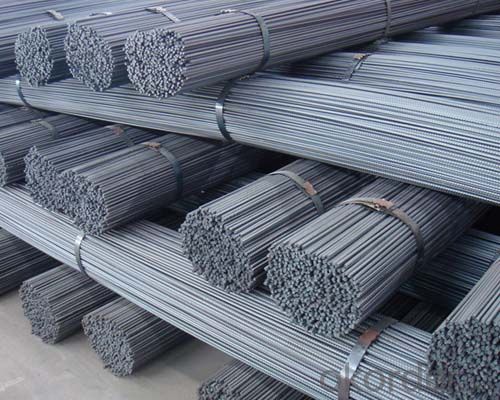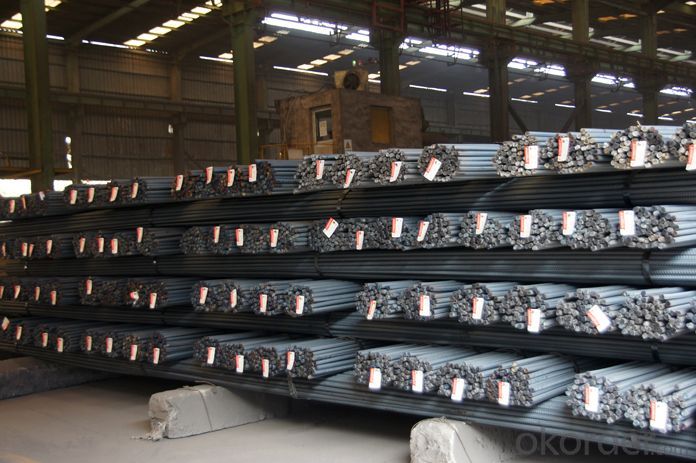Deformed bars with grade HRB400,high quality
- Loading Port:
- Tianjin
- Payment Terms:
- TT OR LC
- Min Order Qty:
- 25 m.t.
- Supply Capability:
- 100000 m.t./month
OKorder Service Pledge
OKorder Financial Service
You Might Also Like
Product Description:
Specifications of HRB400 Deformed Steel Bar:
Standard | GB | HRB400 | |
Diameter | 10mm-32mm | ||
Length | 6M, 12M | ||
Place of origin | Hebei, China mainland | ||
Advantages | exact size, regular package, chemical and mechanical properties are stable. | ||
Type | Hot rolled deformed steel bar | ||
Chemical Composition: (Please kindly find our chemistry of our material based on HRB400 as below for your information)
Grade | Technical data of the original chemical composition (%) | ||||||
C | Mn | Si | S | P | V | ||
HRB400 | ≤0.25 | ≤1.60 | ≤0.80 | ≤0.045 | ≤0.045 | 0.04-0.12 | |
Physical capability | |||||||
Yield Strength (N/cm²) | Tensile Strength (N/cm²) | Elongation (%) | |||||
≥400 | ≥570 | ≥14 | |||||
Theoretical weight and section area of each diameter as below for your information:
Diameter(mm) | Section area (mm²) | Mass(kg/m) | Weight of 12m bar(kg) |
18 | 254.5 | 2.00 | 24 |
20 | 314.2 | 2.47 | 29.64 |
22 | 380.1 | 2.98 | 35.76 |
Usage and Applications of HRB400 Deformed Steel Bar:
Deformed bar is widely used in buildings, bridges, roads and other engineering construction. Big to highways, railways, bridges, culverts, tunnels, public facilities such as flood control, dam, small to housing construction, beam, column, wall and the foundation of the plate, deformed bar is an integral structure material. With the development of world economy and the vigorous development of infrastructure construction, real estate, the demand for deformed bar will be larger and larger..
Packaging & Delivery of HRB400 Deformed Steel Bar:
Packaging Detail: products are packed in bundle and then shipped by container or bulk vessel, deformed bar is usually naked strapping delivery, when storing, please pay attention to moisture proof. The performance of rust will produce adverse effect.
Each bundle weight: 2-3MT, or as required
Payment term: TT or L/C
Delivery Detail: within 45 days after received advanced payment or LC.
Label: to be specified by customer, generally, each bundle has 1-2 labels
Trade terms: FOB, CFR, CIF



*If you would like to get our price, please inform us the size, standard/material and quantity. Thank you very much for your attention.
- Q:How do steel rebars affect the overall lifespan of bridge structures?
- Steel rebars play a crucial role in enhancing the overall lifespan of bridge structures. By reinforcing concrete, rebars increase the tensile strength and structural integrity of the bridge, enabling it to bear heavy loads and withstand various environmental factors such as wind, earthquakes, and temperature fluctuations. This reinforcement prevents cracking, corrosion, and premature failure of the structure, ultimately extending its lifespan and ensuring the safety and reliability of the bridge for an extended period of time.
- Q:Can steel rebars be used in school construction?
- Yes, steel rebars can be used in school construction. Steel rebars are commonly used in the construction industry to reinforce concrete structures, including buildings and infrastructure. In school construction, using steel rebars ensures the strength and durability of the building, providing a safe and long-lasting environment for students and staff.
- Q:What grade of reinforcement is used for cast-in-place floorslab?
- Compared with the floor slab, the cast-in-place concrete can strengthen the integrity and the seismic resistance of the building, and has greater bearing capacity. At the same time, in insulation, sound insulation, waterproof and other aspects also have certain advantages.
- Q:What is the process of handling and transporting steel rebars on-site?
- Ensuring the safe and efficient movement of steel rebars on-site involves a series of steps. To begin, the construction site receives the steel rebars, unloading them from the delivery truck and inspecting for any damage or defects. Once unloaded, the rebars are stored in a designated rebar yard, where they are arranged and stacked for easy access and protection against damage or tangling. Depending on the construction project's requirements, the rebars may be cut or bent to a specific shape before installation, utilizing specialized tools and equipment. After cutting and bending, the rebars are transported to the designated work area on the construction site. This can be done manually by workers or with the assistance of mechanical equipment like cranes or forklifts for larger quantities. In the work area, the rebars are installed according to the project's design and specifications, being placed within the appropriate positions in the concrete structure. Throughout the entire process, strict adherence to safety guidelines is crucial to prevent accidents or injuries. This includes wearing protective gear and ensuring that the rebars are handled and transported in a manner that minimizes the risk of tripping or falling. Regular inspections should also be conducted to detect any damage or defects, as these can compromise the structural integrity of the construction project.
- Q:Can steel rebars be used in earthquake-prone regions?
- Yes, steel rebars can be used in earthquake-prone regions. Steel rebars are commonly used in construction to reinforce concrete structures and improve their strength and durability. In earthquake-prone regions, where buildings need to withstand seismic forces, using steel rebars can help enhance the overall structural integrity and resistance to earthquakes. The flexibility and high tensile strength of steel rebars allow them to absorb and distribute the energy generated during an earthquake, reducing the risk of structural failure and potential collapse.
- Q:Are there any limitations to using steel rebars in construction?
- Yes, there are some limitations to using steel rebars in construction. One limitation is that steel rebars can corrode when exposed to moisture and oxygen, especially in environments with high humidity or near coastal areas where saltwater can accelerate corrosion. This can weaken the structure over time and may require regular maintenance and inspections to prevent structural failure. Another limitation is that steel rebars have a high thermal conductivity, which means they can conduct heat and cold more easily than other materials. This can result in increased energy transfer and potentially affect the overall energy efficiency of the building. Steel rebars are also heavy and require specialized equipment for handling and installation. This can increase construction costs and may limit their use in certain applications where weight is a concern, such as in high-rise buildings or in areas with weak soil conditions. In addition, steel rebars are susceptible to electromagnetic interference, which can be a concern in buildings with sensitive electronic equipment or in areas with high levels of electromagnetic radiation. Lastly, steel rebars are not environmentally friendly as their production contributes to carbon dioxide emissions. They also have a high embodied energy, meaning a significant amount of energy is required to manufacture and transport them. Overall, while steel rebars are widely used in construction due to their strength and durability, it is important to consider these limitations and assess whether alternative materials or construction methods would be more suitable for specific projects.
- Q:How do steel rebars affect the overall fire safety of a structure?
- Steel rebars can significantly enhance the fire safety of a structure. Due to their high melting point and excellent heat conductivity, steel rebars act as reinforcements that help maintain the structural integrity of a building during a fire. They prevent the concrete from cracking and collapsing prematurely, allowing occupants more time to evacuate safely. Additionally, steel rebars can also facilitate the distribution of heat, reducing the risk of localized hotspots and minimizing the potential for structural failure.
- Q:What are the standards and specifications for steel rebars?
- The standards and specifications for steel rebars vary depending on the country and industry. However, some common standards followed globally include ASTM A615/A615M, ASTM A706/A706M, BS 4449:2005, and EN 10080. These standards define the requirements for the chemical composition, mechanical properties, dimensions, and tolerances of steel rebars used in construction and infrastructure projects. Additionally, specific projects or organizations may have their own additional specifications to ensure the quality and performance of the rebars.
- Q:How do steel rebars affect the overall load distribution of concrete structures?
- Steel rebars significantly affect the overall load distribution of concrete structures by providing tensile strength and reinforcing the concrete. The rebars absorb and distribute the applied load throughout the structure, reducing the risk of cracking and enhancing the structural integrity. Without rebars, concrete structures would be more prone to failure under heavy loads or external forces.
- Q:Are steel rebars cost-effective compared to other reinforcement materials?
- Yes, steel rebars are generally considered to be cost-effective compared to other reinforcement materials. Steel has a high strength-to-weight ratio, making it durable and efficient for construction projects. Additionally, steel rebars are readily available, easy to work with, and have a long lifespan, reducing maintenance and replacement costs. Overall, these factors contribute to the cost-effectiveness of steel rebars in comparison to alternative reinforcement materials.
1. Manufacturer Overview |
|
|---|---|
| Location | |
| Year Established | |
| Annual Output Value | |
| Main Markets | |
| Company Certifications | |
2. Manufacturer Certificates |
|
|---|---|
| a) Certification Name | |
| Range | |
| Reference | |
| Validity Period | |
3. Manufacturer Capability |
|
|---|---|
| a)Trade Capacity | |
| Nearest Port | |
| Export Percentage | |
| No.of Employees in Trade Department | |
| Language Spoken: | |
| b)Factory Information | |
| Factory Size: | |
| No. of Production Lines | |
| Contract Manufacturing | |
| Product Price Range | |
Send your message to us
Deformed bars with grade HRB400,high quality
- Loading Port:
- Tianjin
- Payment Terms:
- TT OR LC
- Min Order Qty:
- 25 m.t.
- Supply Capability:
- 100000 m.t./month
OKorder Service Pledge
OKorder Financial Service
Similar products
New products
Hot products
Related keywords





























